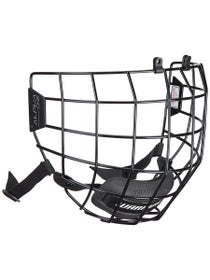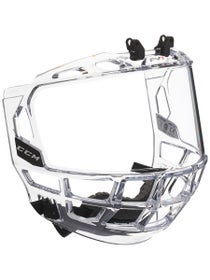How to Size and Select a Hockey Cage
Nothing provides better facial protection than a hockey cage or full hockey shield. Typically made from steel or titanium wire, cages are designed in a grid-like construction to allow for vision of the play but more importantly guard the face against puck, stick, and other hockey-related impacts. New hockey helmets typically come in a helmet and cage combo, but if you're looking to upgrade or purchase a cage for the first time, you've come to the right place. We will discuss how to size and select the right hockey cage for your game, along with certification requirements, cage styles, and their benefits. We'll cap things off with a quick tutorial on installing the cage to your hockey helmet before you hit the rink.

How to Size a Hockey Cage
Hockey cages and full shields often follow the same sizing guidelines. They typically come in Small, Medium, or Large and correspond to your helmet size. If you have a Small helmet, get a Small cage; if it's a Medium Helmet, get a Medium cage, etc. Some full shields may also come in junior or senior sizes, which in this case you want to check the manufacturer's sizing chart to ensure a proper combination. With that said, it is always best to check the manufacturer's compatibility and sizing chart to ensure a proper fit, as some cages are designed to fit a specific helmet brand or model.

Hockey Helmet Cage

Hockey Helmet Cage Hardware

How to Select a Hockey Cage
Many leagues require players to wear certified hockey cages or full shields to ensure their safety and league compliance. Along with being certified, they must be free from damage, and in good working condition with visible certification stickers. Some Hybrid Shields may not be certified, so it's important to check for proper certification. Here are the three main certifications to look for and their respective countries:
HECC (Hockey Equipment Certification Council) - Players 20 years old and younger who play in Minor USA hockey leagues. HECC-certified cages and shields expire roughly 6.5 years after the date of manufacture, which is stamped on the certification sticker.
CSA - (Canadian Standards Association) - All females and players 20 years old and younger who play in Minor Canadian hockey leagues. CSA certification has no official expiration date.
CE (Conformité Européenne) - Players 20 years old and younger who play in IIHF-sanctioned leagues. CE certification has no official expiration date.
Regardless of the expiration date, leagues and officials may reject worn-out, altered, or damaged equipment. If your cage has rust, structural deformity, missing certification stickers, and does not fit your face properly, it's time to replace it before it's rejected by an official.
The images above are different styles of full facial protection for hockey players, each offering their own benefits and drawbacks. From left to right: Cage, Full Shield, Hybrid Shield (combination of both).
| Style | Best For | Pro | Con |
|---|---|---|---|
| Cage | Players who prioritize protection | Best breathability and durability | Reduced visibility |
| Full Shield | Players seeking unobstructed vision | Lightweight and best visibility | Less airflow which can cause fogging issues |
| Hybrid Shield | Balance between visibility and breathability | Clear upper vision with lower cage protection and breathability | It may still fog and some leagues might not allow |
Cage: Easily the most popular, the Cage style offers the best protection since it's built with a steel or titanium construction, offering excellent impact protection. Steel is the most common and more affordable, while Titanium models are more expensive yet much lighter and provide better resistance to rust. While cages provide the best breathability for full facial protection, the bars can reduce visibility and take new players some time to adjust.
Cages also come in different colors, such as black, white, chrome, and silver. Black cages help minimize glare and provide a better range of vision since everything seems brighter. White cages improve contrast which can help players track the puck easier against the ice. Silver cages offer a neutral visibility that doesn't create significant contrast or distraction for the player, while chrome cages have the same visibility as silver but with a more flashy style.
Full Shield: For players who prioritize vision, Full Shields offer crystal-clear visibility thanks to the visor on the upper half of the construction. The lower half features a polycarbonate cage-like design that provides full facial protection, however, airflow is more limited compared to a cage, therefore it's more prone to fogging during gameplay.
Hybrid Shield: The Hybrid Shield combines the best of both worlds, featuring a clear polycarbonate visor for clear visibility and a steel or titanium cage on the lower half for optimal protection and breathability. This design improves airflow compared to a full shield while maintaining better visibility than a traditional cage. Hybrids may still be prone to fogging, and some leagues may not approve this style, so always check certification requirements before using.

How to Install a Hockey Helmet Cage
Installing a cage or full shield is relatively simple and only requires a few materials and tools for installation. Before you get started, you'll need your helmet, cage or full shield, mounting hardware (usually included), and screwdriver (Phillips or flathead, depending on your screws). The following are general guidelines and some models may come with specific installation instructions that you should follow instead.
Step 1. Place your helmet on a flat surface to keep it stable while working and lay out your tools and hardware for easy access. For hardware, make sure you have two top hinge clips, two J-clips, two dome screws, and six short screws with t-nut posts.
Step 2. Align the top of the cage with the front of your helmet and secure the top clips near the forehead. If screws are already installed in the helmet, remove them before attaching the clips.
Step 3. Secure the J-clips to each side of the helmet near the temples and replace the two screws on the back of the helmet with the dome snap screws. This location is right behind the ear covers and above the ear loops.
Step 4. Now it's time to check for fit and make any adjustments. Put on your helmet and attach the chin straps to the dome snaps. Your chin should be centered in the chin cup and comfortable when your mouth is closed. The top of the cage should be flush with the J-clips, which limits movement of the cage on impact. If the cage is too tight or if there is any movement when shaking your head, adjust the J-clips and chin straps for a proper fit. If the fit still feels too loose or too tight, consider sizing up or down for a better fit.
Frequently Asked Questions
How do I know what size hockey cage I need?
In general, your hockey cage should match your helmet size. Most cages come in Small, Medium, or Large to correspond to helmet sizes. Always check the manufacturer's guidelines and sizing charts to find the right cage size and helmet compatibility.
What is the difference between a cage, full shield, and hybrid shield?
Cages offer the most protection and breathability and are built with either steel or titanium wires. For the best visibility, full shields offer a clear view and are built with a polycarbonate visor and lower cage. Hybrid shields are a mix between the two, offering the best balance of vision and breathability. They have a polycarbonate visor and either a steel or titanium wire design for the lower half of the face.
What's the difference between steel and titanium cages?
Steel cages are known for their durability, protection, and affordability. Titanium cages are more expensive but offer a lighter design without sacrificing protection. They also provide more resistance to rust than steel cages.
How should a hockey cage fit?
The top of the cage should sit flush with the J-clips, and your chin should fit snugly against the chin cup when your mouth is closed. It should allow for slight movement when opening your mouth but should not be able to shift out of its position when shaking your head.
Are all hockey cages and full shields compatible with any helmet?
Not always, some models are only compatible with specific helmets from certain brands. While most cages and full shields are universal between helmets and brands, always refer to the manufacturer's guidelines before purchasing.
How do I adjust the chin cup for the best fit?
Some cages or full shields have adjustable chin cups for fine-tuning your fit. For others, you may need to adjust the cage straps that secure the cage to your helmet or the J-clips on the side of your helmet.
How do I take care of my hockey cage?
Steel cages and the installation hardware are the most prone to rusting. You should avoid leaving your helmet inside your hockey bag after a game or practice. It's best practice to take it out and wipe it down with a cloth to dry when you get home. Before each time you play, check to make sure the hardware is still secure, as it can loosen and fall out.
How do I install a hockey cage?
Attach the top of the cage to the front of your helmet near the forehead. Install the J-clips on each side near the temples so it properly holds the cage at the right height. Screw in the dome snaps on the back of the helmet. Adjust the length of the cage straps so that your chin sits comfortably inside the chin cup when the straps secure the cage to your helmet.
How do I stop my full shield from fogging up?
Avoid touching the inside of the visor with your hands. You can apply an anti-fog spray before and after each game or practice. During the game, some players flip up their shield between shifts to allow airflow inside.
How often should I replace my cage or full shield?
You should always replace your cage or full shield if it no longer fits properly and there is damage, such as bends, cracks, excessive rust, or scratches that obstruct your vision. Players who require HECC certification must replace their cage or full shield when it expires, which is usually 6.5 years from the date of manufacture. This date is stamped onto the HECC certification sticker.




